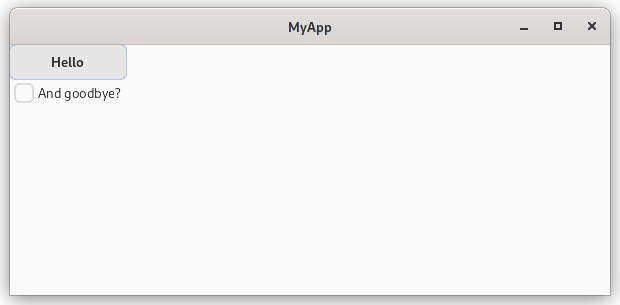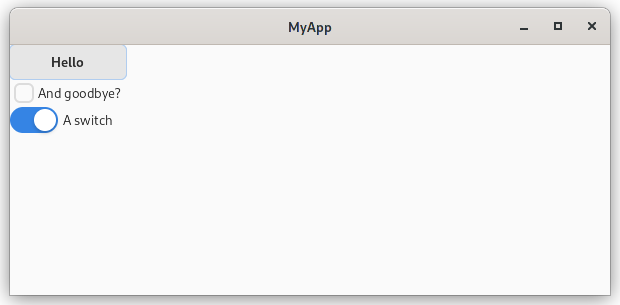Bitchin GTK4 Python tutorial
Wanna make apps for Linux but not sure how to start with GTK? Frustrated with the style of GTK4 documentation. This guide will hopefully get you started!
Prerequisite: You have learnt the basics of Python
A most basic program
import gi
gi.require_version('Gtk', '4.0')
from gi.repository import Gtk
def on_activate(app):
win = Gtk.ApplicationWindow(application=app)
win.present()
app = Gtk.Application(application_id='com.example.GtkApplication')
app.connect('activate', on_activate)
app.run(None)
This should display a small blank window.
Oh btw, you'll want to think of an application id for your app, especially if you're going to distribute it. It should be the reverse of a domain or page you control. If you dont have your own domain you can do like "com.github.me.myproject".
Right um... lets make that code into classes! Cause doing it functional style is a little awkward in Python.
Also, Libawaita is the new hotness, so lets switch to that!
Aaand we'll pass the app arguments in.
Here's what we got now:
A better structured basic GTK4 + Adwaita
import sys
import gi
gi.require_version('Gtk', '4.0')
gi.require_version('Adw', '1')
from gi.repository import Gtk, Adw
class MainWindow(Gtk.ApplicationWindow):
def __init__(self, *args, **kwargs):
super().__init__(*args, **kwargs)
# Things will go here
class MyApp(Adw.Application):
def __init__(self, **kwargs):
super().__init__(**kwargs)
self.connect('activate', self.on_activate)
def on_activate(self, app):
self.win = MainWindow(application=app)
self.win.present()
app = MyApp(application_id="com.example.GtkApplication")
app.run(sys.argv)
Soo we have an instance of an app class and a window which we extend! We run our app and it makes a window!
Dont worry too much if your Python knowledge isn't strong and the __init__(self, *args, **kwargs) stuff is giving you a headache.
So! Whats next?
Well, we want to add something to our window. That would likely be a layout of some sort!
Most basic layout is a Box.
Lets add a box to the window! (Where the comment "things will go here" is above)
self.box = Gtk.Box()
self.set_child(self.box)
We make a new box, and attach it to the window. Simple. If you run the app now you'll see no difference, because there's nothing in the layout yet either.
Add a button!
One of the most basic widgets is a Button. Let's make one and add it to the layout.
self.button = Gtk.Button(label="Hello")
self.box1.append(self.button)
Now our app has a button! (The window will be small now)
But it does nothing when we click it. Let's connect it to a function! Make a new method that prints hello world, and we connect it!
Here's our MainWindow so far:
class MainWindow(Gtk.ApplicationWindow):
def __init__(self, *args, **kwargs):
super().__init__(*args, **kwargs)
self.box1 = Gtk.Box(orientation=Gtk.Orientation.VERTICAL)
self.set_child(self.box1)
self.button = Gtk.Button(label="Hello")
self.box1.append(self.button)
self.button.connect('clicked', self.hello)
def hello(self, button):
print("Hello world")
Cool eh?
By the way the Box layout lays out widgets in like a vertical or horizontal order. We should set the orientation of the box. See the change:
self.box1 = Gtk.Box(orientation=Gtk.Orientation.VERTICAL)
Quick intermission, lets set some fun stuff
self.set_default_size(600, 250)
self.set_title("MyApp")
More boxes
You'll notice our button is stenched with the window. Let's add two boxes inside that first box we made.
self.box1 = Gtk.Box(orientation=Gtk.Orientation.HORIZONTAL)
self.box2 = Gtk.Box(orientation=Gtk.Orientation.VERTICAL)
self.box3 = Gtk.Box(orientation=Gtk.Orientation.VERTICAL)
self.button = Gtk.Button(label="Hello")
self.button.connect('clicked', self.hello)
self.set_child(self.box1) # Horizontal box to window
self.box1.append(self.box2) # Put vert box in that box
self.box1.append(self.box3) # And another one, empty for now
self.box2.append(self.button) # But button in the first of the two vertial boxes
Now that's more neat!
Add a check button!
So, we know about a button, next lets add a Checkbutton.
...
self.check = Gtk.CheckButton(label="And goodbye?")
self.box2.append(self.check)
def hello(self, button):
print("Hello world")
if self.check.get_active():
print("Goodbye world!")
self.close()
When we click the button, we can check the state of the checkbox!
Add a switch
For our switch, we'll want to put our switch in a Box, otherwise it'll look all stretched.
...
self.switch_box = Gtk.Box(orientation=Gtk.Orientation.HORIZONTAL)
self.switch = Gtk.Switch()
self.switch.set_active(True) # Let's default it to on
self.switch.connect("state-set", self.switch_switched) # Lets trigger a function
self.switch_box.append(self.switch)
self.box2.append(self.switch_box)
def switch_switched(self, switch, state):
print(f"The switch has been switched {'on' if state else 'off'}")
Try it out!
Our switch is looking rather nondescript, so lets add a label to it!
Add a Label
A label is like a basic line of text
self.label = Gtk.Label(label="A switch")
self.switch_box.append(self.switch)
self.switch_box.set_spacing(5) # Add some spacing
It should look like this now:


